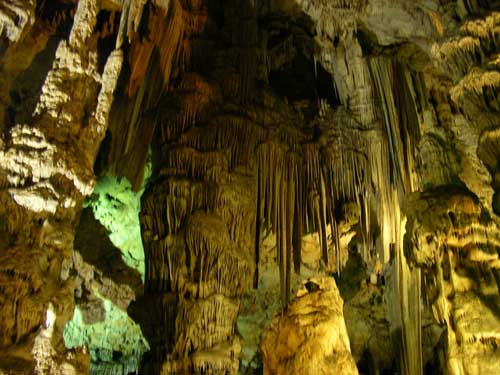 by Preston MacDougall April 19, 2007
It makes me want to crawl into a CAVE. While it is just as possible, I am not afraid of a similar tragedy occurring here at Middle Tennessee State University, which is like Virginia Tech in some ways; a large, state-supported university, set in a college town, surrounded by lots of beautiful scenery. 
Furthermore, the CAVE I want to take you to is hardly a safe distance from the site of the massacre - it is right in the middle of the Virginia Tech campus! The VT-CAVE is a Cave Automatic Virtual Environment that was installed on the campus of Virginia Tech nine years ago this April. CAVEs were invented, in 1992, by scientific visualization researchers at the University of Illinois at Chicago. In these virtual reality chambers, a computer projects images on all four walls, and the floor (which also moves in newer models). The occupants, or digital-age spelunkers, can experience a simulated environment controlled by someone else, anywhere on the planet, or they themselves can be in the driver's seat. Student and faculty researchers, studying anything and everything between aerodynamics and art history, have been given a passport to the VT-CAVE. You can see the CAVE yourself, as well as some of the visualization projects explored inside it, at www.cave.vt.edu. If all this sounds like something that would help your son or daughter to finally "get" chemistry, you're right, it would help a lot. But you should also know that CAVEs cost a lot of money. For instance, the one at Virginia Tech was funded by a $1.6 million Academic Research Infrastructure grant from the National Science Foundation. And keeping the projectors on, not to mention the costs associated with software development and maintenance, isn't cheap either. So while others are pointing their fingers at Virginia Tech for administrative actions that, in hindsight, may seem questionable, I would like to point my finger at Virginia Tech as an example of excellent, innovative, very well-funded education, that is highly accessible. I'm not a Hokie, but I have been there - nine years ago this past February. I marveled at the colorful hills that Blacksburg is fully immersed in, and also at the beautiful buildings on campus. Many are made from what locals call "Hokie stone" (a locally-mined dolomite limestone), including those in the stately engineering complex where I gave a Materials Science and Engineering Seminar in the building next to the now infamous Norris Hall. I talked about some of the novel computational chemistry research that I had recently done with scientific visualization researchers at the NASA Ames Research Center in the heart of Silicon Valley. Some of the simulation tools that we used, for research on materials that may be useful in nanotechnology, were borrowed from aerodynamics research done in gigantic wind tunnels. As odd as this may sound to the untrained ear, this is not uncommon in cutting-edge research, where great leaps forward can be sharp turns from what you thought was the next logical step. The darker flip-side, of course, is that technological catastrophes can also blindside you. Perhaps you noted a small chronological detail in this story. The VT-CAVE had its grand opening two months after I gave my seminar. I can still recall the excitement and anticipation that filled the room when a few engineering professors told me of the CAVE that they were building. Instead of projected on a screen at the front of a lecture room, they could envision being surrounded by the unique molecular images that they saw during my seminar. So could I. Once again, my thoughts and wishes are in harmony with the faculty and students at Virginia Tech, where the unexpected makes me want to crawl into a CAVE.
On the Web:
Publish A Letter on SitNews Read Letters/Opinions Submit A Letter to the Editor
|